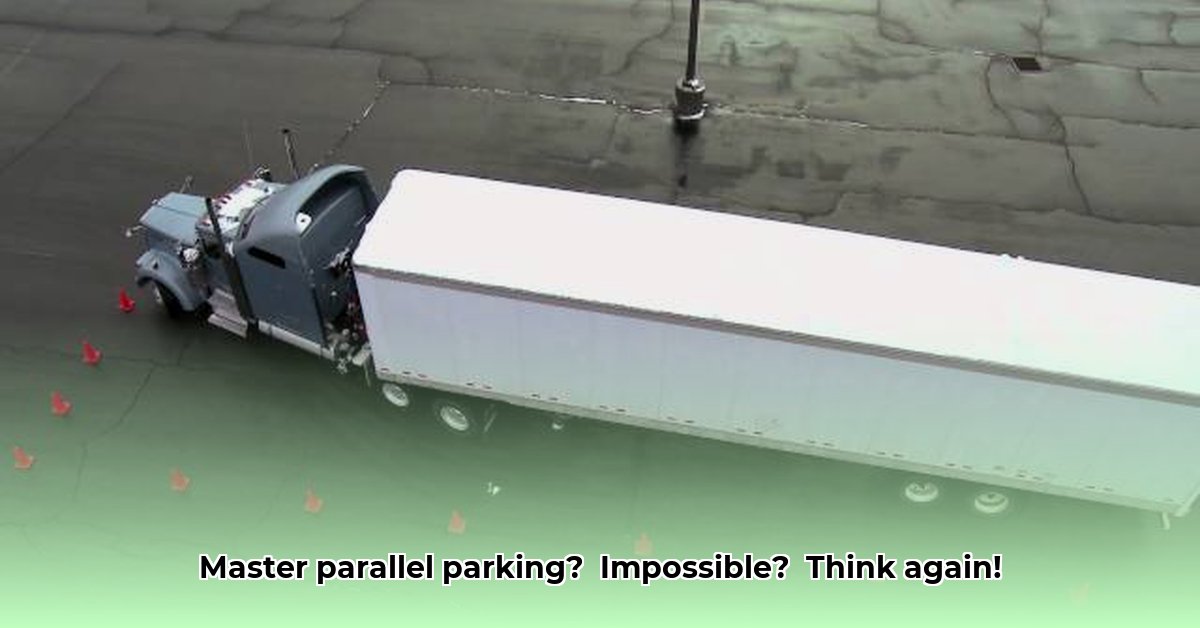
Mastering the Art of Parallel Parking: Two Proven Methods
Parallel parking a tractor-trailer is a critical skill for any CDL driver. While initially daunting, mastering this maneuver is achievable with the right technique and sufficient practice. This guide compares two popular methods – Katlaw's methodical approach and Mooney's more intuitive technique – to help you choose the best strategy for your learning style and skill level. Are you ready to conquer the parking lot? For more comprehensive CDL training, check out this helpful resource: CDL Training.
Katlaw's Method: The Precision Approach
This method prioritizes precision and control, breaking the maneuver into easily manageable steps. It's ideal for beginners who prefer a structured learning process. Think of it as a step-by-step recipe for successful parking.
Finding the Perfect Spot: Identify a parking space at least 1.5 times the length of your trailer. Align your rear bumper with the rear bumper of the vehicle in front of your desired spot. This provides ample space for maneuvering.
The Initial Turn: Sharply turn your steering wheel to the right. Begin backing up slowly and smoothly, constantly monitoring your mirrors. Aim for a 45-degree angle to the curb.
Straightening Out: Once you reach the 45-degree angle, straighten your steering wheel. Continue backing up steadily, smoothly adjusting as needed to align with the curb.
Fine Tuning: Make any necessary minor adjustments with the steering wheel to achieve perfect alignment with both the curb and the vehicle in front. Patience is key here – rushing can lead to errors.
Katlaw's method, while reliable, might feel less efficient in extremely tight spaces. However, its structured approach makes it an excellent choice for building confidence and foundational skills.
Mooney's Method: The Intuitive Approach
Mooney's method favors intuition and on-the-spot adjustments. It's faster once mastered, but requires more experience and a keen sense of your truck's dimensions. Consider this the "artistic" approach to parallel parking.
Strategic Positioning: Position your truck slightly further from the vehicle in front than with Katlaw's method, setting yourself up for a wider initial turn.
The Bold Turn: More aggressively turn the steering wheel to the right compared to Katlaw's method. Heavy reliance on mirrors and spatial awareness is crucial here.
Quick Corrections: As you back up, quickly straighten the wheel and make smaller, reactionary corrections while constantly observing your surroundings and trailer positioning in the mirrors.
Precision Parking: Fine-tune your position with small steering wheel adjustments to achieve perfect alignment.
Mooney's method excels in tight spaces where speed and efficiency are paramount. However, it demands greater experience and a strong understanding of your truck's behavior. This approach is best suited for experienced drivers who can confidently read the trailer's movement.
Comparing the Methods: A Side-by-Side Analysis
Choosing the right method depends on your skill level and comfort zone. Here's a comparison to help you decide:
| Feature | Katlaw's Method | Mooney's Method |
|---|---|---|
| Difficulty | Easier for beginners, more forgiving | More challenging, requires experience |
| Space Required | Requires more initial space | Adaptable to tighter spaces |
| Speed | Slower, controlled | Faster, but potentially more error-prone |
| Best For | Beginners, those prioritizing precision | Experienced drivers, tight spaces |
| Success Rate | High success rate with consistent practice | High success rate with experience and practice |
Conclusion: Practice Makes Perfect
Both Katlaw's and Mooney's methods can lead to success. The key is consistent practice. Start with the method that best suits your starting skill level and gradually transition to the more advanced technique as your confidence and skill grow. Remember, safety is paramount. The ultimate goal is to develop a technique that feels comfortable, efficient, and safe for you. Mastering parallel parking isn't just about passing your CDL test; it's about becoming a safer, more skilled professional driver.